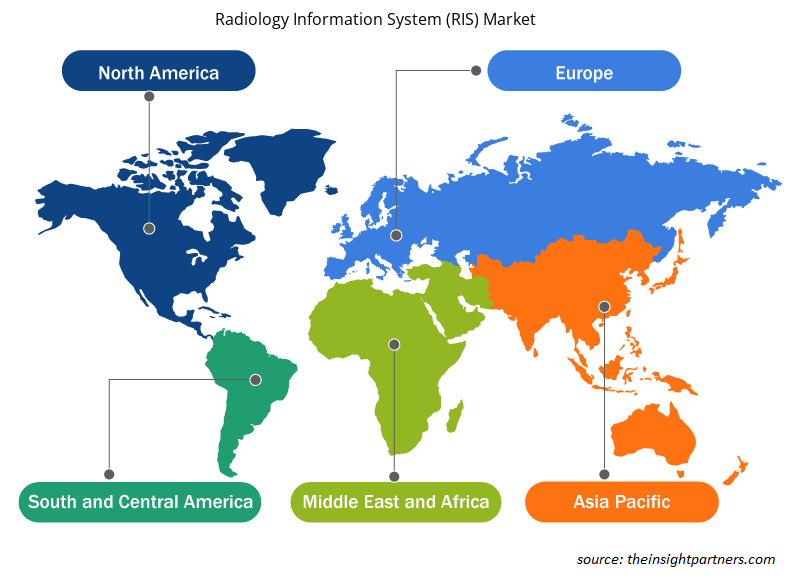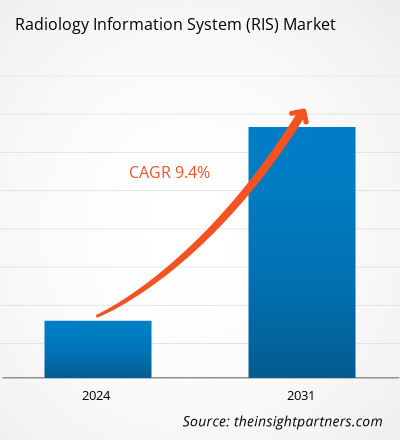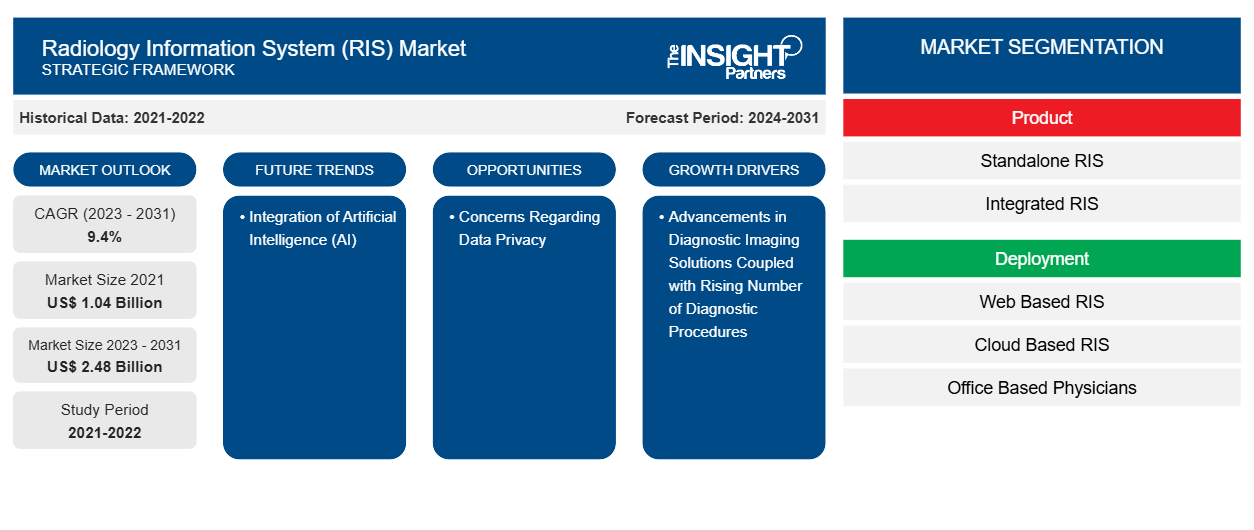La dimensione del mercato dei sistemi informativi radiologici (RIS) nel 2021 era di 1,04 miliardi di $ USA e si prevede che raggiungerà i 2,48 miliardi di $ USA entro il 2031 dai XX miliardi di $ USA nel 2023. Si prevede che il mercato registrerà un CAGR del 9,4% nel 2023-2031. La crescente consapevolezza riguardo ai sistemi informativi radiologici (RIS) con i suoi minori rischi per la salute e il tasso di adozione nelle regioni in via di sviluppo probabilmente rimarranno tendenze chiave del mercato dei sistemi informativi radiologici (RIS).
Analisi di mercato del sistema informativo radiologico (RIS)
I principali fattori di crescita del mercato includono l'aumento dei tassi di incidenza delle malattie croniche, l'accesso ai sistemi di tecnologia informatica sanitaria e i finanziamenti governativi per la ricerca sul cancro. Inoltre, il peso delle malattie croniche sta aumentando in tutto il mondo, insieme al crescente invecchiamento della popolazione, e disturbi correlati allo stile di vita come cancro, artrite, malattie cardiovascolari e diabete sono alcuni dei principali fattori responsabili della crescita di questo mercato. Si prevede che un aumento dei casi di cancro porterà a un'attenzione maggiore sui servizi di radiologia per una diagnosi appropriata, che dovrebbe aumentare la domanda di sistemi informativi radiologici. L'aumento delle malattie croniche come il cancro sta aumentando la domanda di sistemi informativi radiologici. Tuttavia, si prevede che l'elevato costo di installazione e la mancanza di manodopera qualificata ostacoleranno la crescita del mercato durante il periodo di studio.
Panoramica del mercato dei sistemi informativi radiologici (RIS)
RIS è un software sanitario specializzato progettato per gestire e semplificare le operazioni dei centri di radiologia e imaging. RIS archivia, gestisce e distribuisce immagini radiologiche , informazioni sui pazienti e dati correlati. I continui progressi tecnologici, tra cui apprendimento automatico, apprendimento profondo e integrazione dell'intelligenza artificiale nell'assistenza sanitaria, miglioreranno l'accuratezza e l'efficienza dei sistemi di radiologia. Inoltre, la crescente domanda di soluzioni sanitarie integrate per migliorare l'assistenza ai pazienti e semplificare i flussi di lavoro sta portando all'adozione di RIS. Le normative e le iniziative governative promuovono anche la standardizzazione dei dati e delle cartelle cliniche. Forniscono inoltre incentivi per l'adozione di servizi IT sanitari, che dovrebbero avere un impatto positivo sulle opportunità di crescita del mercato.
Personalizza questo report in base alle tue esigenze
Riceverai la personalizzazione gratuita di qualsiasi report, comprese parti di questo report, o analisi a livello nazionale, pacchetto dati Excel, oltre a usufruire di grandi offerte e sconti per start-up e università
-
Scopri le principali tendenze di mercato in questo rapporto.Questo campione GRATUITO includerà analisi di dati che spaziano dalle tendenze di mercato alle stime e alle previsioni.
Driver e opportunità del mercato dei sistemi informativi radiologici (RIS)
Progressi nelle soluzioni di diagnostica per immagini per favorire il mercato
L'introduzione dell'imaging digitale ha trasformato il campo della radiologia. Ha catalizzato la transizione dall'imaging tradizionale basato su pellicola ai formati digitali, ha ottimizzato la gestione dei dati e ha aumentato l'accessibilità. L'elaborazione delle immagini digitali ha anche portato a miglioramenti significativi nella qualità delle immagini. RIS consente al personale sanitario di fissare appuntamenti per i pazienti sia in regime di ricovero che ambulatoriale. La radiologia ha fatto progressi verso la gestione computerizzata nel servizio sanitario e ha risposto alla domanda di comunicazioni rapide ed economiche tra i reparti di radiologia e i loro utenti. Negli ultimi anni, ci sono stati vari sviluppi nelle modalità di imaging all'interno dell'assistenza sanitaria per scopi diagnostici. Negli ultimi anni, sono stati fatti molti progressi nella radiografia digitale , tra cui l'interpretazione dei raggi X assistita dall'intelligenza artificiale, l'imaging a doppia energia, la tomosintesi, la diagnosi assistita dal computer, l'unione automatica delle immagini e la radiografia mobile digitale. Questi progressi hanno portato a una migliore qualità delle immagini, contribuendo a migliorare l'assistenza ai pazienti e a ottenere risultati migliori per i pazienti. Inoltre, l'uso della radiografia digitale riduce la necessità di ripetere l'imaging, il che ha il vantaggio di una minore esposizione alle radiazioni.
Crescente adozione di servizi IT sanitari nelle economie emergenti: un'opportunità per la crescita del mercato dei sistemi informativi radiologici (RIS)
A livello globale, c'è una crescente necessità di adozione della tecnologia nei servizi di radiologia per soddisfare le richieste. Il futuro di RIS risiede nell'uso dell'intelligenza artificiale (IA) e dell'apprendimento automatico (ML). Gli algoritmi di IA possono aiutare i radiologi ad analizzare le immagini, rilevare anomalie e supportare le decisioni. Gli algoritmi di ML possono apprendere continuamente da enormi quantità di dati e perfezionare diagnosi e piani di trattamento. Una migliore connettività tramite Internet e tecnologia mobile, teleradiologia, intelligenza artificiale, sviluppi nell'informatica per l'imaging medico e dispositivi di imaging medico portatili o mobili possono consentire a località remote in qualsiasi paese di accedere a un'assistenza sanitaria e a una diagnostica migliori. Inoltre, nei paesi in via di sviluppo, i sistemi sanitari stanno diventando più tecnologicamente amichevoli poiché i paesi stanno vivendo un'internazionalizzazione dell'assistenza come marchi affermati. Ad esempio, la Cleveland Clinic con sede negli Stati Uniti ha ampliato i propri mercati negli Emirati Arabi Uniti e la start-up inglese Babylon, un'app di diagnostica per l'assistenza primaria basata sull'apprendimento automatico e sull'IA, è entrata in Cina e Ruanda.
Analisi della segmentazione del rapporto di mercato del sistema informativo radiologico (RIS)
I segmenti chiave che hanno contribuito alla derivazione dell'analisi di mercato del sistema informativo radiologico (RIS) sono prodotto, distribuzione, componente e utente finale.
- In base al prodotto, il mercato dei sistemi informativi radiologici (RIS) è diviso in RIS standalone e RIS integrato. Nel 2023, il segmento RIS integrato deteneva la quota maggiore del mercato e si prevede che lo stesso segmento registrerà il CAGR più elevato durante il periodo di previsione.
- In base all'implementazione, il mercato è segmentato in RIS basati sul web, RIS basati sul cloud, RIS on-premises. Nel 2023, il segmento RIS basato sul web deteneva la quota maggiore del mercato. Tuttavia, si prevede che il segmento RIS basato sul cloud registrerà il CAGR più elevato nel periodo 2023-2031.
- In base al componente, il mercato dei sistemi informativi radiologici (RIS) è categorizzato in hardware, software e servizi. Nel 2023, il segmento dei servizi ha detenuto la quota maggiore del mercato e si prevede che il segmento del software registrerà il CAGR più elevato durante il periodo di previsione.
- In termini di utente finale, il mercato è segmentato in medici ambulatoriali, ospedali e fornitori di servizi sanitari di emergenza. Nel 2023, il segmento ospedaliero deteneva la quota maggiore del mercato e si stima che lo stesso segmento registrerà il CAGR più elevato durante il periodo di previsione.
Analisi della quota di mercato del sistema informativo radiologico (RIS) per area geografica
L'ambito geografico del rapporto di mercato sui sistemi informativi radiologici (RIS) è suddiviso principalmente in cinque regioni: Nord America, Asia Pacifico, Europa, Medio Oriente e Africa e Sud America/Sud e Centro America.
Il Nord America ha dominato il mercato dei sistemi informativi radiologici (RIS). Si prevede che la domanda per il mercato nella regione registrerà una crescita a un tasso significativo a causa di diversi fattori come gli investimenti governativi nelle infrastrutture sanitarie, la crescente consapevolezza riguardo all'imaging medico e i vantaggi associati all'implementazione di RIS. Negli Stati Uniti, fattori come il gran numero di centri di imaging in questa regione, il rapido ritmo dei progressi tecnologici, la crescente popolazione geriatrica e la crescente domanda di diagnosi assistita da computer sono alcuni dei principali fattori di crescita di questo mercato. Inoltre, si prevede che la presenza di varie aziende impegnate nello sviluppo di sistemi avanzati di RIS per l'imaging diagnostico di malattie cardiovascolari, ortopediche, odontoiatriche e oncologiche offrirà opportunità di crescita per la crescita del mercato. Tuttavia, si prevede che l'Asia Pacifica crescerà con il CAGR più elevato nei prossimi anni a causa di fattori come la crescita del settore delle tecnologie informatiche sanitarie in questa regione a causa del miglioramento delle infrastrutture sanitarie e dell'aumento del tasso di adozione di tecniche sanitarie avanzate da parte dei consumatori.
Approfondimenti regionali sul mercato dei sistemi informativi radiologici (RIS)
Le tendenze regionali e i fattori che influenzano il mercato del Radiology Information System (RIS) durante il periodo di previsione sono stati ampiamente spiegati dagli analisti di Insight Partners. Questa sezione discute anche i segmenti di mercato del Radiology Information System (RIS) e la geografia in Nord America, Europa, Asia Pacifico, Medio Oriente e Africa e Sud e Centro America.

- Ottieni i dati specifici regionali per il mercato del sistema informativo radiologico (RIS)
Ambito del rapporto di mercato del sistema informativo radiologico (RIS)
| Attributo del report | Dettagli |
|---|---|
| Dimensioni del mercato nel 2021 | 1,04 miliardi di dollari USA |
| Dimensioni del mercato entro il 2031 | 2,48 miliardi di dollari USA |
| CAGR globale (2023-2031) | 9,4% |
| Dati storici | 2021-2022 |
| Periodo di previsione | 2024-2031 |
| Segmenti coperti |
Per Prodotto
|
| Regioni e Paesi coperti |
America del Nord
|
| Leader di mercato e profili aziendali chiave |
|
Densità degli attori del mercato del sistema informativo radiologico (RIS): comprendere il suo impatto sulle dinamiche aziendali
Il mercato del Radiology Information System (RIS) sta crescendo rapidamente, spinto dalla crescente domanda degli utenti finali dovuta a fattori quali l'evoluzione delle preferenze dei consumatori, i progressi tecnologici e una maggiore consapevolezza dei vantaggi del prodotto. Con l'aumento della domanda, le aziende stanno ampliando le loro offerte, innovando per soddisfare le esigenze dei consumatori e capitalizzando sulle tendenze emergenti, il che alimenta ulteriormente la crescita del mercato.
La densità degli operatori di mercato si riferisce alla distribuzione di aziende o società che operano in un particolare mercato o settore. Indica quanti concorrenti (operatori di mercato) sono presenti in un dato spazio di mercato in relazione alle sue dimensioni o al valore di mercato totale.
Le principali aziende che operano nel mercato dei sistemi informativi radiologici (RIS) sono:
- Koninklijke Philips NV,
- Siemens Healthineers AG,
- La Bayer AG,
- Società Cerner,
- Compagnia elettrica generale,
- Società McKESSON,
Disclaimer : le aziende elencate sopra non sono classificate secondo un ordine particolare.

- Ottieni la panoramica dei principali attori del mercato dei sistemi informativi radiologici (RIS)
Notizie di mercato e sviluppi recenti del sistema informativo radiologico (RIS)
Il mercato dei sistemi informativi radiologici (RIS) viene valutato raccogliendo dati qualitativi e quantitativi post-ricerca primaria e secondaria, che includono importanti pubblicazioni aziendali, dati associativi e database. Di seguito è riportato un elenco degli sviluppi nel mercato dei sistemi informativi radiologici (RIS):
- Royal Solutions Group, un fornitore leader di software per l'assistenza sanitaria, è lieto di annunciare l'espansione della sua partnership con Concord Technologies. L'integrazione di tecnologia aggiuntiva dalla suite Practical AI di Concord di soluzioni all'avanguardia per l'elaborazione dei dati consente di scansionare facilmente sia le note digitate che quelle scritte a mano e di estrarre e integrare i dati nei flussi di lavoro. Ciò promette di trasformare il modo in cui gli studi medici gestiscono l'immissione degli ordini, l'indicizzazione e l'autorizzazione preventiva. Automatizzando questi processi critici, i professionisti sanitari sono autorizzati a concentrarsi sull'assistenza ai pazienti anziché sulla burocrazia. (Royal Solutions Group, LLC, Comunicato stampa, 2024)
- Manipal Hospitals, uno dei principali fornitori di servizi sanitari in India, ha stipulato un accordo con FUJIFILM India. In base all'accordo a lungo termine, Manipal Hospitals riceverà un Picture Archiving and Communication System (PACS) su larga scala, alimentato da FUJIFILM India. Il PACS elimina la necessità di archiviare, recuperare e inviare manualmente informazioni sensibili, filmati e report. (FUJIFILM India Private Limited, News, 2023)
- PARATUS acquisisce la quota di maggioranza di IMAGE Information Systems. IMAGE è un fornitore leader di PACS al servizio di centri di imaging e ospedali in tutto il mondo. Questo investimento da parte di PARATUS è un elemento strategico per stabilire un fornitore leader mondiale di software e servizi IT per l'assistenza sanitaria. (RADiQ IMAGE Information Systems, News, 2023)
- Philips lancia nuove soluzioni informatiche potenziate dall'intelligenza artificiale per aumentare l'affidabilità diagnostica con l'intelligenza in ogni fase del flusso di lavoro radiologico presso RSNA. (Koninklijke Philips NV, Notizie, 2022)
Copertura e risultati del rapporto di mercato sui sistemi informativi radiologici (RIS)
Il rapporto "Dimensioni e previsioni del mercato dei sistemi informativi radiologici (RIS) (2021-2031)" fornisce un'analisi dettagliata del mercato che copre le seguenti aree:
- Dimensioni e previsioni del mercato a livello globale, regionale e nazionale per tutti i segmenti di mercato chiave coperti dall'ambito
- Dinamiche di mercato come fattori trainanti, vincoli e opportunità chiave
- Principali tendenze future
- Analisi dettagliata delle cinque forze PEST/Porter e SWOT
- Analisi di mercato globale e regionale che copre le principali tendenze di mercato, i principali attori, le normative e gli sviluppi recenti del mercato
- Analisi del panorama industriale e della concorrenza che copre la concentrazione del mercato, l'analisi della mappa di calore, i principali attori e gli sviluppi recenti
- Profili aziendali dettagliati
- Analisi storica (2 anni), anno base, previsione (7 anni) con CAGR
- Analisi PEST e SWOT
- Valore/volume delle dimensioni del mercato - Globale, Regionale, Nazionale
- Industria e panorama competitivo
- Set di dati Excel
Report recenti
Testimonianze
Motivo dell'acquisto
- Processo decisionale informato
- Comprensione delle dinamiche di mercato
- Analisi competitiva
- Analisi dei clienti
- Previsioni di mercato
- Mitigazione del rischio
- Pianificazione strategica
- Giustificazione degli investimenti
- Identificazione dei mercati emergenti
- Miglioramento delle strategie di marketing
- Aumento dell'efficienza operativa
- Allineamento alle tendenze normative























 Ottieni un campione gratuito per - Mercato dei sistemi informativi radiologici (RIS)
Ottieni un campione gratuito per - Mercato dei sistemi informativi radiologici (RIS)